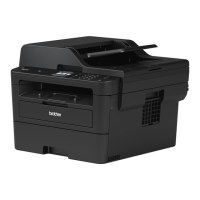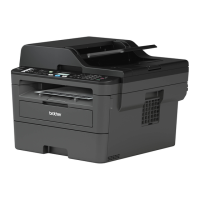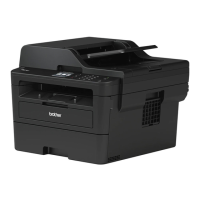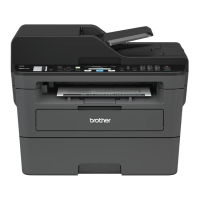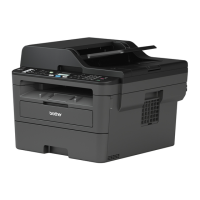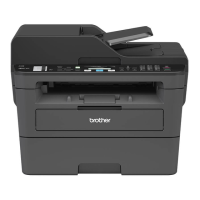





Do you have a question about the Brother MFC-L2720DW and is the answer not in the manual?
Explains the physical controls and display of the machine, including the LCD, touchpanel, and buttons.
Details navigation and features available on the machine's touchscreen interface, including modes and settings.
Guides users through the initial configuration steps, such as setting date/time and adjusting volumes.
Instructions on how to launch and use the Brother Utilities software for managing the machine.
Explains the meaning of the WiFi indicator light on the machine for network connectivity status.
Provides information on checking toner levels and the meaning of associated error icons.
Instructions on setting up custom shortcuts for frequently used operations on the machine.
Step-by-step guide for loading paper correctly into the machine's paper tray.
How to set the correct paper size and type for optimal printing performance.
Lists recommended paper types and specifications for achieving the best print quality.
Guidelines and warnings for using specialty papers like envelopes, labels, or cardstock.
Basic instructions for printing documents from a computer application.
How to enable and configure automatic duplex (2-sided) printing for documents.
Instructions for printing multiple pages from a document onto a single sheet of paper.
Specific methods for printing documents on envelopes, thick paper, or labels.
Guide for printing documents using the machine's manual feed slot.
Step-by-step process for making a standard copy of a document.
Details on adjusting copy quality, density, contrast, and page layout options.
Instructions for copying documents onto both sides of the paper.
How to copy both sides of an identification card onto a single page efficiently.
Guide to scanning documents and photos using computer software like ControlCenter4.
Instructions for initiating scans directly from the machine's control panel buttons.
How to configure basic fax settings, including setting station identification and phone numbers.
Adjusting settings for compatibility with different telephone lines, including interference and VoIP.
Explains different modes for automatically receiving faxes or handling voice/fax calls.
Instructions for storing, changing, and deleting contact numbers in the machine's address book.
Step-by-step guide for sending faxes using the machine's interface, dial pad, or address book.
How to send and receive faxes directly from a computer using PC-FAX software.
Initial checks and methods for diagnosing and resolving common machine problems.
Explains common error codes and maintenance alerts and provides corresponding solutions.
Solutions for problems related to sending or receiving faxes and handling telephone calls.
Procedures for finding and clearing various types of document and paper jams within the machine.
Steps to resolve issues when printing or scanning documents fails or produces errors.
Instructions on how to use the on-screen keyboard for text input on the machine.
Information about replacement toner cartridges and drum units for the machine.
| Print technology | Laser |
|---|---|
| Maximum resolution | 2400 x 600 DPI |
| Economical printing | Yes |
| Duplex printing mode | Auto |
| Time to first page (black, normal) | 8.5 s |
| Duplex print speed (ISO/IEC 24734) mono | 15 ipm |
| Print speed (black, normal quality, A4/US Letter) | 3 ppm |
| Duplex print speed (black, normal quality, A4/US Letter) | 7.5 ppm |
| Copier resize | 25 - 400 % |
| Maximum copy resolution | 600 x 600 DPI |
| Maximum number of copies | 99 copies |
| Copy speed (black, normal quality, A4) | 30 cpm |
| Scan to | E-mail, E-mail Server, File, FTP, Image |
| Scan drivers | ICA, TWAIN, WIA |
| Scanner type | Flatbed scanner |
| Grayscale levels | 256 |
| Input color depth | 30 bit |
| Maximum scan area | A4 (210 x 297) mm |
| Output color depth | 24 bit |
| Maximum scan resolution | 19200 x 19200 DPI |
| Optical scanning resolution | 600 x 2400 DPI |
| Faxing | Mono faxing |
| Fax memory | 500 pages |
| Modem speed | 33.6 Kbit/s |
| Fax coding methods | JBIG, MH, MMR (Fax coding method), MR |
| Fax resolution (black) | 203 x 98 DPI |
| Fax speed dialing (max numbers) | 200 |
| PCL fonts | 66 |
| Digital sender | No |
| Printing colors | Black |
| Maximum duty cycle | - pages per month |
| Recommended duty cycle | 250 - 2000 pages per month |
| Number of print cartridges | 1 |
| Page description languages | BR-Script 3, PCL 6 |
| Email protocols | APOP, POP3, SMTP |
| Wi-Fi standards | 802.11b, 802.11g, Wi-Fi 4 (802.11n) |
| Cabling technology | 10/100Base-T(X) |
| Security algorithms | 128-bit WEP, 64-bit WEP, APOP, SMTP-AUTH, SNMP, WPA-AES, WPA-PSK, WPA-TKIP, WPA2-AES, WPA2-PSK, WPS |
| Ethernet LAN data rates | 10, 100 Mbit/s |
| Online services supported | Box, Dropbox, Evernote, Facebook, Flickr, Google Drive, OneDrive, Picasa |
| Mobile printing technologies | Apple AirPrint, Brother iPrint & Scan, Google Cloud Print |
| Supported network protocols (IPv4) | ARP, RARP, BOOTP, DHCP, APIPA(Auto IP), WINS/NetBIOS name resolution, DNS resolver, mDNS, LLMNR responder, LPR/LPD, Custom Raw Port/Port 9100, IPP, FTP Server, SNMPv1/v2c/v3, HTTP Server, TFTP Client/Server, SMTP Client, ICMP, Web Services (Print/Scan), SNTP Client, POP3, IMAP4 |
| Supported network protocols (IPv6) | NDP, RA, DNS Resolver, mDNS, LLMNR responder, LPR/LPD, Custom Raw Port/ Port 9100, IPP, FTP Server, SNMPv1/v2c/v3, HTTP Server, TFTP Client/Server, SMTP Client, ICMPv6, Web Services (Print/Scan), SNTP Client, POP3, IMAP4 |
| Fax compatibility | ITU-T G3 |
| Processor family | ARM |
| Sound power level (standby) | 33 dB |
| Sound pressure level (printing) | 50 dB |
| Sound pressure level (quiet mode) | 45 dB |
| Paper input type | Paper tray |
| Total input capacity | 250 sheets |
| Total output capacity | 100 sheets |
| Auto document feeder (ADF) input capacity | 35 sheets |
| Custom media width | 76.2 - 215.9 mm |
| Custom media length | 127 - 355.6 mm |
| Paper tray media types | Bond paper, Envelopes, Labels, Plain paper, Recycled paper, Thick paper, Thicker paper, Thin paper |
| Paper tray media weight | 60 - 105 g/m² |
| Non-ISO print media sizes | Executive |
| ISO A-series sizes (A0...A9) | A4, A5, A6 |
| Maximum ISO A-series paper size | A4 |
| Multi-Purpose Tray media weight | 60 - 163 g/m² |
| Display | LCD |
| Control type | Touch |
| Display diagonal | 2.7 \ |
| Market positioning | Home & office |
| Standard interfaces | Ethernet, USB 1.1, USB 2.0, Wireless LAN |
| USB 2.0 ports quantity | USB 2.0 ports have a data transmission speed of 480 Mbps, and are backwards compatible with USB 1.1 ports. You can connect all kinds of peripheral devices to them. |
| AC input voltage | 220 - 240 V |
| AC input frequency | 50 - 60 Hz |
| Power consumption (max) | 1104 W |
| Power consumption (off) | 0.08 W |
| Power consumption (standby) | 60 W |
| Power consumption (PowerSave) | 6.6 W |
| Power consumption (average operating) | 510 W |
| Minimum storage drive space | 50 MB |
| Mac operating systems supported | Mac OS X 10.7 Lion, Mac OS X 10.8 Mountain Lion, Mac OS X 10.9 Mavericks |
| Server operating systems supported | Windows Server 2003, Windows Server 2003 x64, Windows Server 2008, Windows Server 2008 R2, Windows Server 2008 x64, Windows Server 2012, Windows Server 2012 R2 |
| Windows operating systems supported | Windows 7 Home Basic, Windows 7 Home Basic x64, Windows 7 Home Premium, Windows 7 Home Premium x64, Windows 7 Professional, Windows 7 Professional x64, Windows 7 Starter, Windows 7 Starter x64, Windows 7 Ultimate, Windows 7 Ultimate x64, Windows 8, Windows 8 Enterprise, Windows 8 Enterprise x64, Windows 8 Pro, Windows 8 Pro x64, Windows 8 x64, Windows Vista Business, Windows Vista Business x64, Windows Vista Enterprise, Windows Vista Enterprise x64, Windows Vista Home Basic, Windows Vista Home Basic x64, Windows Vista Home Premium, Windows Vista Home Premium x64, Windows Vista Ultimate, Windows Vista Ultimate x64, Windows XP Home, Windows XP Home x64, Windows XP Professional, Windows XP Professional x64 |
| Bundled software | Brother Control Center 4\\r Nuance PaperPort 12 SE\\r Brother Control Center 2 |
| Sustainability certificates | Nordic Swan Ecolabel, Blue Angel, ENERGY STAR |
| Storage temperature (T-T) | 0 - 40 °C |
| Operating temperature (T-T) | 10 - 32 °C |
| Storage relative humidity (H-H) | 10 - 90 % |
| Operating relative humidity (H-H) | 20 - 80 % |
| Package depth | 517 mm |
| Package width | 567 mm |
| Package height | 435 mm |
| Package weight | 14600 g |
| Depth | 399 mm |
|---|---|
| Width | 409 mm |
| Height | 317 mm |

